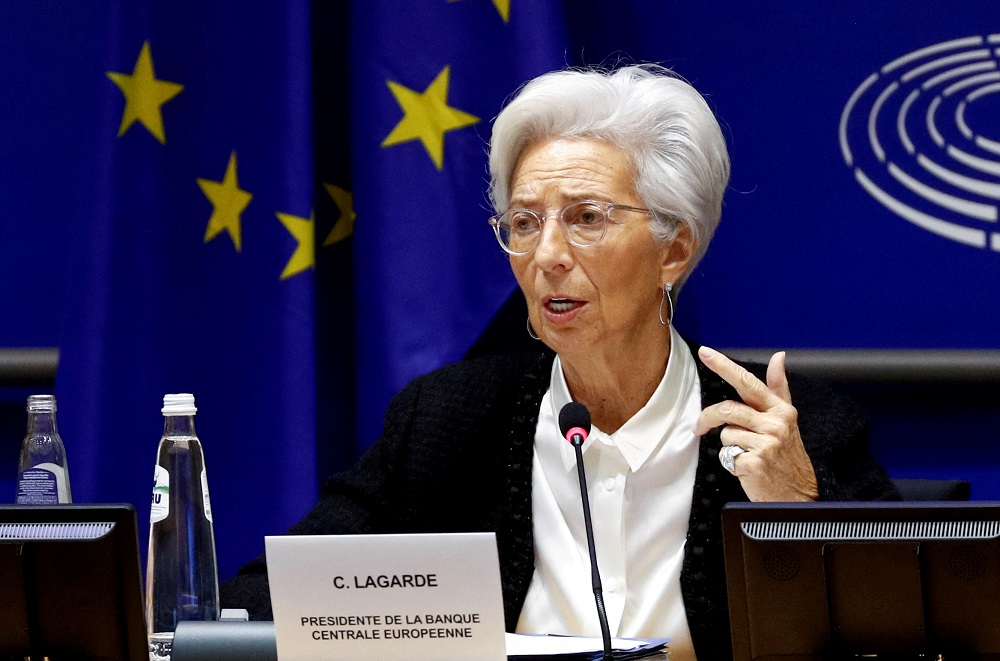ECB has fallen behind the curve again?
If you look at market pricing of rate policy this year, you will see that it projects that the ECB will start to reduce rates a little later than the Fed and cut rates in all by no more than the Fed through 2024.

C. Lagarde, President of the ECB
>> Outlook for central banks’s monetary policy in 2024
This seems a little odd, what with the euro zone economy virtually in recession and inflation falling more rapidly. Perhaps the market is pricing policy this way because it fears that the ECB will fall behind the curve again.
When the Fed first hiked rates in March 2022, there was criticism that it was behind the curve given that PCE inflation was already around 5.5%; the highest it has been in this cycle. In the months that followed the criticism grew and the Fed responded by upping the rate hikes to 50-bps from the initial 25-bps hike, and then on to 75-bps.
But in this time the ECB did nothing; it did not start hiking until July, some four months after the Fed. Admittedly, inflation had not risen as sharply in the euro zone but the writing was clearly on the wall given how inflation across the globe was shooting higher with European gas prices particularly stratospheric.
In short, if the Fed was behind the curve, the ECB was even further behind. Fast forward to today and there seems a clear risk that the ECB will be far behind the curve on the way down as well, at least relative to the Fed. For unless something changes dramatically, such as a quick and deep recession in the US, there seems no reason on economic grounds in the Standard Bank’s view to justify a later start by the ECB and be only on level pegging with the rate cuts delivered by the Fed this year.
At the moment the market is priced for both the Fed and ECB to cut rates by 100-bps. Even taking into account that the Fed has lifted rates by more in this cycle, such an outcome would mean the ECB falling behind the curve again. In fact, that might be one reason why the market is not more aggressive in its rate cut expectations for the ECB this year. It is because the ECB has a history of falling behind the curve.
Now admittedly, former ECB President Draghi did seem to push back against this with rate decisions that seemed a little more rapid, but Lagarde seems to have gone back to the rather tortuous consensus building within the ECB that seems to delay rate action. Of course, this does change in cases of emergency when a quick and rapid policy response is undeniably needed, such as we saw during the pandemic. But, for more ‘normal’ cycles the ECB seems to fall behind. The need for consensus building is arguably the main reason compared to other central banks where all that’s required is a simple majority vote. It also seems to us that the ECB becomes too cumbersome in the way it lays out the justification for any future policy changes.
>> Will FED cut rates before the ECB?
For instance, right now it lists three requirements for lower policy rates: an inflation outlook that’s in line with the target, adequate declines in underlying inflation, and evidence of strength in the transmission in its monetary policy. You don’t hear the Fed saying that three conditions have to be satisfied for rates to be cut. One seems to be enough; an inflation outlook that’s consistent with the target. It is almost as if the ECB puts up hurdles to future policy action and clearing each of these hurdles just delays the process.
The key issue in all, this is whether the more tentative approach of the ECB weighs on the performance of things like stocks, bonds and the euro. It does, for even if we argue that falling behind the curve now compared to the Fed might lift the euro because rate differentials will improve in the euro’s favour, that’s of little benefit to the currency if the cost is much more significant, and perhaps unnecessary economic duress.
However, all might not be lost. For if the Fed is quicker out of the blocks to cut rates, it could lift risk appetite as the global financial cycle goes from being a bane to a being a support for financial assets. That’s an environment where the dollar tends to fall even if the ECB is behind the curve. Hence, euro bulls will have to hope that the Fed can work some magic if the euro is not to become vulnerable because the ECB has fallen behind the curve again.








